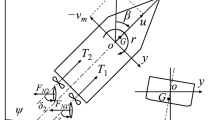Abstract
It is possible for a twin-screw ship that one screw failure occurs during navigation, and the maneuverability in this case should be noticed by ship designers and operators. It is of great significance to evaluate the related risk. Firstly, a mathematical model for the twin-screw ship maneuvering motion with one failed screw is developed based on the maneuvering model group (MMG) equations, and verified by the model test results. Secondly, the maneuvering motions of a twin-screw liquefied natural gas (LNG) ship with one free rotating failure screw or with one locked failure screw are simulated and compared by using the mathematical model. It is shown that the numerical modeling results are in agreement with the model test results. Compared with those of normal navigation, the port turning ability of the ship with one failed port screw is better, but the starboard turning ability and yaw checking ability become worse. The maneuverability of the ship with locked failure screw is better than that with free failure screw, although the ship speed drops obviously.
Similar content being viewed by others
References
VAN ZWIETEN J H, DRISCOLL F R, ALSENAS G M. Response characteristics and maneuverability of a small twin screw displacement hull vessel in seas [J]. Ships and Offshore Structures, 2008, 3(1): 13–40.
ABRAMOWICZ-GERIGK T. Experimental study on the hydrodynamic forces induced by a twin-propeller ferry during berthing [J]. Ocean Engineering, 2008, 35(3): 323–332.
KIM Y G, KIM S Y, KIM H T, et al. Prediction of the maneuverability of a large container ship with twin screws and twin rudders [J]. Journal Maritime Science Technology, 2007, 12(2): 130–138.
DU L H. A study on the maneuverability of twin screw and twin rudder vessel [D]. Dalian: Navigation College, Dalian Maritime University, 2005 (in Chinese).
WEN H, LIU W, YING R R. The resistance calculation on twin-screw ship driven by one screw [C]//Conference of Marine Ship Safety Theory and Practice. Beijing: China Institute of Navigation, 2008: 169–173 (in Chinese).
JIA X L, YANG Y S. Ship motion mathematical motion-mechanism modeling and identification modeling [M]. Dalian: Dalian Maritime University Press, 2000 (in Chinese).
YASUKAWA H, YOSHIMURA Y. Introduction of MMG standard method for ship maneuvering predictions [J]. Journal of Marine Science and Technology, 2015, 20(1): 37–52.
HUANG G L. The report on LNG ship planar motion mechanism captive model tests [R]. Shanghai: Shanghai Jiao Tong University, 2010 (in Chinese).
HUANG G L, LIU T W. The report on LNG ship free model tests [R]. Shanghai: Shanghai Jiao Tong University, 2010 (in Chinese).
Author information
Authors and Affiliations
Corresponding author
Additional information
Foundation item: the Research and Manufacturing of LNG Ship, Ministry of Industry and Information Technology, China (No. K24161)
Rights and permissions
About this article
Cite this article
Liu, X., Fan, S. Investigation on maneuverability of a twin-screw ship driven by one screw. J. Shanghai Jiaotong Univ. (Sci.) 22, 434–439 (2017). https://doi.org/10.1007/s12204-017-1857-x
Received:
Published:
Issue Date:
DOI: https://doi.org/10.1007/s12204-017-1857-x



